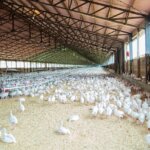
A Weekly Update from the Red River Farm Network
Tuesday, December 31, 2024
Happy New Year! 2024 was an unforgettable year. The Red River Farm Network caps off the year with our annual list of the top ten stories we’ve covered this past year. From politics to erratic weather, agriculture faced numerous highs and lows. The RRFN team of ag journalists compiled its review of these big stories. As the year winds down, RRFN wishes you health, happiness and prosperity in 2025.

#1 -Trump Dominates Election, Rollins Named Ag Secretary-Designate – The 45th president of the United States is in line to also be the country’s 47th president. The election of Donald Trump is ranked at the Red River Farm Network’s #1 of 2024. Veteran Washington analyst Jim Wiesemeyer described Trump’s win as the greatest political comeback in history. Trump won all of the battleground states and expanded his broad support in rural areas. Speculation began immediately in farm country about who would lead USDA in the new administration. Familiar names were part of the discussion, including Indiana farmer Kip Tom and American Farm Bureau President Zippy Duvall. However, Trump picked a relative unknown, Brooke Rollins, who was part of his Domestic Policy Council during the first go-round. Rollin grew up in a town of 1,200 people on the Texas plains; was a state FFA officer; got an ag degree at Texas A&M University and has been a hands-on parent as her four kids showed Hereford cattle.
#2 A Lack of Action on the Farm Bill – “Deja Vu all over again.” Those immortal words from former Yankee catcher Yogi Berra is an accurate description of the farm bill process. This year is ending as it did one year ago with Congress passing a farm bill extension and kicking the can down the road to the New Year for passage of a new five-year farm bill. This situation is RRFN’s #2 ag story of 2024. Minnesota Farm Bureau President Dan Glessing was in Washington, D.C. during the debate over a continuing resolution. The 2025 farm bill debate was top of mind. “Now, this is pretty aspirational, but, G.T. Thompson, the chair of the House Ag Committee, said he wants to have it through committee in the first quarter of next year,” said Glessing. “But, when you look at all those appointments that the Senate would have to confirm it’s going to be a heavy lift to get the whole bill done.”

#3 A Difficult Farm Economy – RRFN’s #3 story for 2024 is the weak farm economy. U.S. net farm income is down for the third consecutive year and another downturn is forecast for 2025. Declining commodity prices, high interest rates and sticky farm input costs are shouldering the blame. The exception has been a bullish beef cattle market and better days in dairy and pork production. AgCentric Executive Director Keith Olander said the individuals who have been farming for five years or less are feeling the biggest hurdle. These farmers experienced times of good profitability, “but, at that stage of the game don’t have a lot of equity” to cushion the blow from the drop in farm income.
#4 Wet Spring/Early Fall – After spring planting delays due to wet conditions, farmers across the Northern Plains and Upper Midwest enjoyed a long, open fall harvest season. That story ranks #4 for the year. Grygla, Minnesota farmer Todd Stanley’s situation was similar to many. “”This isn’t our wettest spring, but it is one of our most trying,” Stanley told RRFN. “It just rains every day or every other day. People have been in the fields over a month and there’s still a fair amount of planting left to do.” Once harvest started, it was a non-stop affair. “We have had a 30-day green flag run,” said Paul Anderson of Coleharbor, North Dakota. “We only took two days for the crew to rest between soybeans and corn.” Ryan Wanzek, who farms near Cleveland, North Dakota, spoke with RRFN in early November and he was close to finishing his corn harvest. “We haven’t had any harvest breaks, so everybody’s getting pretty tired.”

#5 The H5N1 Virus Threat – Highly Pathogenic Avian Influenza has been a harsh reality for commercial poultry operations since 2016. In March, a multi-state outbreak of the virus was confirmed for the first time in U.S. dairy cattle. By April 1, the CDC confirmed a human H5N1 infection in a dairy farm employee. The advancement of the H5N1 virus is ranked as RRFN’s #5 for the past year. The risk to human health remains low, but the threat is real for poultry and dairy farms. More than half of the dairy herds in California have been affected by the virus since August resulting in a state of emergency for the country’s leading milk producer. Avian influenza results in high mortality in poultry operations, but it is more of a production issue in dairy cows. Clinical signs include low appetite and reduced milk production.
#6 EPA Issues Herbicide Strategy – In August, the Environmental Protection Agency released its final Herbicide Strategy. In a statement, the EPA described it as “an unprecedented step in protecting over 900 federally endangered and threatened species from the potential impacts of herbicides.” For decades, the EPA tried to comply with the courts on a pesticide-by-pesticide, species-by-species basis. To minimize future litigation, farmers will now be required to take more stringent measures to reduce spray drift or runoff. North Dakota Agriculture Commissioner Doug Goehring described the EPA’s action as “the most significant imposition of new regulation on the agricultural sector in generations.” The new herbicide strategy is RRFN’s #6 story of 2024.

#7 Klobuchar, Craig Capture Leadership Roles on the Ag Committee – Minnesota is in rare territory for farm policy. Senator Amy Klobuchar and Representative Angie Craig are both serving as the lead Democrats on the agriculture committee in their respective chamber. This scenario is ranked as RRFN’s #7 story of the past year. Klobuchar succeeds Michigan Senator Debbie Stabenow who chose not to run for reelection. Craig took a more unusual route. House Agriculture Committee Ranking Member David Scott, 79, faced health issues and was criticized for his ineffectiveness in farm policy battles. Craig and California Congressman Jim Costa challenged Scott for the job. Scott and Costa are both more senior members of the committee, but Craig came out on top in a vote of her colleagues. When announcing her intention to seek the leadership role, Craig said she worried too many rural Americans don’t believe Democrats have their best interests at heart. “It’s my mission to work with you to help change their minds.”

#8 Horrific Wildfires Hit Western ND – Natural disasters are seen every year, including the devastating Helene and Milton hurricanes. For Texas and North Dakota, the issue was wildfires. Nearly 140,000 acres were impacted by the wildfires in North Dakota. The image of the scorched earth and the property and livestock losses were significant. The North Dakota wildfires are ranked #8 in RRFN’s top stories of the year. The fires were contained by late October, but there is a lingering impact. “Some of the livestock buyers have said they don’t really want to buy cattle out of those areas simply because they’re afraid of pneumonia setting in at a later date or feed efficiency issues, you just don’t have cattle at peak performance when they’re struggling healthwise.” Reported Ag Commissioner Doug Goehring. Thousands of dollars have been raised to help affected ranchers. Resources remain available online.
#9 Dicamba Registration Revoked – In February, a federal court in Arizona vacated the registration of dicamba products, overturning a 2020 EPA reapproval of the herbicides. The loss of this crop protection tool is the #9 story for the Red River Farm Network in 2024. Bob Worth, who was the president of the Minnesota Soybean Growers Association at the time, said the dicamba ruling couldn’t have come at a worse time. “What a game-changer,” said Worth. “This is really a bad time of the year to be having a ruling come out like this; all the farmers have purchased their seed and all their chemicals for next year and dicamba was a big part of that.” BASF, Bayer and Syngenta all reapplied for registration for over-the-top use of dicamba, but approval is unlikely for the 2025 growing season.
#10 Historic Prices for Feeder Cattle – Feeder cattle prices are finishing 2024 are record high levels, rounding out the top ten RRFN ag stories of the year. The average price for 500-pound steer calves is $320 per hundredweight. That’s up 19 percent from last year and up 63 percent from 2022 levels. Strong demand for calves helped counteract seasonal pressure in the local cattle markets. “Usually, the end of October and into November is a tough time to sell calves,” said Tim Petry, livestock economist, North Dakota State University. “This year we’ve seen an increase in the last month (November) which is positive for those selling calves.”

A 2024 Market Recap with Advance Trading’s Brian Basting – The corn market started out 2024 with the highest prices of the calendar year in late January. “That’s extremely rare,” said Brian Basting, economist, Advance Trading. “I can only think of one other time that may have happened in my career stretching back nearly 40 years.” Heading into the New Year, Basting sees an interesting market dynamic. “We’re the primary shop in the world for corn; if you want corn you’re coming to the U.S.” Basting believes USDA could nudge corn exports upward in the upcoming crop reports. In a year-end YouTube interview with the Red River Farm Network, Basting discusses grain markets, the outside markets and a very strong cattle market. “I’m excited about 2025; there’s a lot to be looking forward to in 2025.” Click here for the link to the interview.
Beneficial Ownership Filing Deadline Postponed Again – Beneficial Ownership filing has been put on hold again. “We are back where we were on December 3rd, which is there is no filing deadline for this information as of right now,” said American Farm Bureau Federation Director of Government Affairs Dustin Sherer. It could be a couple of weeks before a permanent decision is reached, but Sherer advises being ready when the time comes. “If you have consulted with an attorney or a CPA or you look at the rules yourself and believe that you are a business owner, it is our strong recommendation that you have all this information gathered up and ready to file should the court decide to reinstate the deadline at some point in the near future.”
NCBA Responds to Corporate Transparency Change – The National Cattlemen’s Beef Association released a statement regarding the latest court developments that suspended the reporting requirement again for the Corporate Transparency Act. The statement says “these court rulings have gone back and forth and continue to add to the confusion.” NCBA is asking Congress to pass legislation to permanently protect farmers and ranchers from this mandate.

Farm Bill Future – The new Congress will convene on Friday and a new farm bill will be on the radar. “We’ve been kicking the can down the road for quite some time,” said Sam Kieffer, vice president of public policy, American Farm Bureau. “The 2018 Farm Bill technically expired two years ago and here we are still operating under short-term extensions.” Kieffer believes Minnesota Senator Amy Klobuchar and Minnesota Representative Angie Craig will help move a modernized farm bill forward. Klobuchar is the new ranking member of the Senate Agriculture Committee and Craig is the new ranking member on the House Ag Committee.
MFU Minute – Minnesota Senator Amy Klobuchar and Minnesota Representative Angie Craig will serve as the lead Democrats on the agriculture committees in 2025. Minnesota Farmers Union President Gary Wertish shares his thoughts about Klobuchar and Craig in this report. Listen to the MFU Minute.

Cramer: New Congressional Leadership Key to Farm Bill Progress – With a new Congress coming in, North Dakota Senator Kevin Cramer is confident a new farm bill will finally happen. “I think it’s also helpful, to have a majority leader that’s from farm country, John Thune has a pretty strong understanding of the importance of a farm bill considering he’s from South Dakota”, said Cramer. “I think a lot of people who eat a lot more food than they’ve ever seen grown may not understand the capital that it takes to put in a crop every spring and harvest it every fall.”
A Trimmed-Down CR Passes – The continuing resolution recently passed by Congress included a short-term spending bill, disaster aid and a one-year farm bill extension. “It’s never exactly the way you want it, but we made some major improvements to it,” said North Dakota Senator John Hoeven. “In terms of the overall legislation, we cut it from about 1,500 pages where it started down to about 100, knocked a lot of stuff out of there that should not be in there and so that’s real progress.” One thing lost in the bill was year-round E-15. Hoeven believes that will be addressed in a new farm bill.
MN Corn Matters – Minnesota Corn Growers Association President Jim Kanten welcomes the passage of the continuing resolution, a one-year farm bill extension, disaster relief and economic relief for farmers. Listen to the report.
Disaster Relief Payment Rates Updated – Ahead of the Christmas holiday, Congress passed a funding bill to avert a government shutdown; extended the farm bill for another year and provided farmers with economic assistance. Green Solutions Group farm management analyst Kent Thiesse said the 2025 economic outlook pushed Congress to action. “There was a survey about a month ago of ag lenders and 80 percent of them either said we were in a recession or headed toward a recession in 2025.” Disaster relief payment rates also received an update. “This will be based on actual planted acres in 2024 as reported to FSA offices and for farmers that maybe have preventive planted acres, half of those acres would also count.”
Job Opportunities in Agriculture – Visit the Red River Farm Network website and click on the Job Opportunities in Agriculture tab. The Roseau County Farm Service Agency has an opening for a full-time program analyst. Contact Dustin Spaeth for more details. January 17th is the application deadline.

ND Legislative Report ’25 Debuts Friday – The North Dakota legislative session begins Tuesday, January 7th. RRFN follows the news coming out of Bismarck in our news programming and with our exclusive North Dakota Legislative Report. Each Friday at 6:37 AM. The North Dakota Legislative Report is sponsored by the Northern Pulse Growers Association, North Dakota Grain Growers Association, North Dakota Farmers Union, North Dakota Corn Growers Association, AgCountry Farm Credit Services and NDFB.

Session to Begin With GOP in the Majority in MN House – Last week, a Ramsey County judge disqualified Representative-elect Curtis Johnson on residency grounds amid a challenge by his Republican opponent. The outcome gives Republicans a 67-66 edge in the Minnesota House until the seat is filled in a special election. “Never seen something like this,” said Stu Lourey, government relations director, Minnesota Farmers Union. “This is a budget year and we need to pass a new biannual budget for the Department of Agriculture, for education, transportation, everything that state government does. We remain hopeful that even with these challenges, folks will find that bipartisanship and come together for a good budget at the end of the year.” The session starts on January 14th. The special election will be held January 28th.
Public Waters Likely to be Reviewed in St. Paul – The budget will likely be the biggest hurdle for the Minnesota Legislature with a projected deficit in 2028-2029. Representative Paul Anderson, who is a farmer from Starbuck, said water issues will be monitored. A year ago, the Minnesota DNR was given $8 million over eight years to come up with a new map for public waters. “The troubling thing is the statutory definition remained in place that said anything that drains up to two square miles could be mapped as a public water,” said Anderson. “I really want to look at that again and try to use common sense because that could impact a lot of areas, especially the (Red River) Valley area where we have a lot of land that’s relatively flat and drains.” Anderson will be leading the House Agriculture Committee and said legislative priorities include the response to H5N1 and other animal health diseases and permitting.
Dry Bean Scene – In this week’s Dry Bean Scene, Minnesota Farm Service Agency Deputy State Executive Director Daniel Mahoney discusses specialty crop assistance. Listen to the report.
Grains Markets Face Headwinds in New Year – The grains markets face an uphill battle going into 2025. However, University of Minnesota Grain Market Economist Ed Usset sees some upside in the corn and wheat markets. The soybean markets are a different story. “The problem is there are three horses in this deal, corn, soybeans, and wheat, and one of those horses is a real laggard; that’s the soybean market. Corn and wheat are just struggling to find their footing to make a strong surge upward with the soybean market the way it is.”
U.S. Grain Markets Face Uncertainty – With all the uncertainties facing U.S. grains markets in 2025, strong trade relations are more important than ever. “With soybeans, you consider the fact that over half of what’s produced is exported and these markets took years to develop, we’re obviously very concerned about any kind of mitigation of those export markets,” said Soy Transportation Coalition Executive Director Mike Steenhoek. “When you have the potential of having some of these real key markets like China being reduced, that’s clearly going to have a negative impact on our industry.”
What’s Hot, What’s Not in the Markets – In this week edition of What’s Hot, What’s Not in the Markets, Martinson Ag Risk Management President Randy Martinson describes corn as “the little engine that could,” trading at its highest level since June. Even with corn prices edging higher, cattle markets remains strong. The wheat and soybean markets are in the “not hot” category. Listen to Martinson.
Optimism for the Brazilian Soybean Crop – Despite planting delays, the Brazilian agricultural agency, CONAB, has good things to say about the crop. In its latest report, CONAB said the soybean crop has recovered from the initial delays and has benefitted from recent rainfall. This report cites the conditions in Mato Grosso, Mato Grosso do Sul, Gois and Parana in surpassing the country’s highest crop index values of the past.

Brazil to Double Soybean Processing – Brazil is significantly expanding its soybean processing capacity to meet rising demand for biodiesel. This rapid growth, nearly double the rate of the previous three years, is driven by Brazil’s ‘Fuel of the Future’ law, which mandates increasing the vegetable oil content in biodiesel from 14 percent to 17 percent by 2027. This policy shift will fuel a 34 percent surge in soybean oil demand, with biodiesel consumption projected to rise from 9.3 billion liters in 2024 to 12.3 billion liters in 2027. Despite the substantial increase in domestic demand, Brazil’s soybean oil exports are expected to remain stable at around 1 million metric tons annually, lower than the five-year average of 1.8 million metric tons.
MN Exports Surge – Minnesota exports rose to $6.7 billion in the last quarter, an 11 percent increase over the same period last year. The growth of Minnesota exports outpaced the three percent national rate for the quarter and outperformed all but 12 other states. The two largest export markets for Minnesota are Canada and Mexico. The sale of miscellaneous grain and oilseeds was up 47 percent. Meat sales rose 27 percent.
Last Saltie of the Season – The last oceangoing vessel left the Port of Duluth-Superior over the weekend, ending the 2024 navigation season. This ship was carrying durum and wheat and is heading to North Africa. The amount of agricultural commodities moving through the port hit its highest level in four years.
Canola Minute – The Canola Minute is a presentation of the Northern Canola Growers Association. This week, NCGA Executive Director Barry Coleman provides an update about recent misinformation on seed oils. Listen to the report.

Uncertainty Heading Into 2025 – As 2025 approaches, farmers are weighing multiple factors from crop quality to policy changes. “It’s probably been a little more unique this year than other years, “said Andrew Schultz, sales manager, CHS Ag Services. Because of the price uncertainties, Schultz said many growers haven’t made final decisions on what to plant next season. “Nothing, outside of sugar beets, pencils out the greatest so we’ve seen growers are somewhat undecided between wheat and beans, especially.” Schultz said weather will be the determining factor in whether we see more wheat or soybeans planted next year.
Consider Disease Risk – Brevant Seed Retail Sales Agronomist Tyler Stastny says disease pressure was a big problem this past growing season. Stastny wants farmers to consider that when making decisions for 2025. Tar Spot was one of his bigger challenges. “You take Northern Corn Leaf Blight for instance, there’s a 20-25 day cycle and with Tar Spot, it’s 11 days. You think about fast that particular disease can come from the bottom of the canopy up and really be detrimental.” Stastny said Identifying the disease is the first job. Listen to the interview.
Strategic Seed Selection – Seed selection can have a dramatic impact on yields and a farmer’s bottom line. CROPLAN Market Activation Manager Robert Cossar says choosing the right seed is about more than just performance. “It’s all about yield, It’s about bushels across the scales, as I like to say.” Cossar thinks farmers shouldn’t let low commodity prices affect the seed selection process. “When we have low commodity prices, it’s easy to pull back to protect the cash flow, but we know that if you start pulling back to lesser-yielding genetics, then you give up cash on the back side.”
MN Beef Update – Minnesota Beef Council Communications Director Ashley Wulf joins the Minnesota Beef Update with a special holiday message. Listen to this message.
Developing the Beef Industry’s Long-Range Plan – Two longtime North Dakota Stockmen’s Association members are part of the new Beef Industry Long Range Planning Committee; Clark Price, Washburn, and Larry Schnell, Dickinson. In an interview with RRFN, Price said the cattle industry is in a good place. “Our numbers are low, which is reflected in the price of cattle right now. Most sectors are profitable right now, but we’re in short supply and we all know that that will change over time.” Policy and sustainability have been a focus in recent years, but Price says funding will be a priority going into the next five-year plan. “Our dollar that was implemented into the checkoff side of things in 1986 is now worth somewhere around 30 cents equivalent to that time. I think the need for additional funding is big.”
Swine Inventory Up 1% – As of December 1, the inventory of hogs and pigs totaled 75.8 million head. That’s up one percent from one year ago, but down slightly from the previous quarter. USDA livestock analyst Michael McConnell said margins have improved for pork producers. “Lower feed costs have helped producers as the price of corn and soybean meal have been relatively low and that helped returns for much of 2024.” Pork demand has also been good. Iowa is the #1 hog production state with 24.6 million head. Minnesota has the second-largest inventory at 9.5 million head.
USDA Boosts Support for Organic Dairy Producers – USDA is allocating an extra $8.7 million to help organic dairy farmers offset rising costs and market instability. The money is part of the Organic Dairy Marketing Assistance program for 2024. This brings the total funding for the program to over $31 million. Payments will be based on 2023 or projected 2024 marketing costs.
Cargill to Acquire Golden Growers Interest in ProGold – Cargill will buy Golden Growers Cooperative’s interest in the ProGold corn wet milling plant when their current lease expires in two years. Cargill started leasing the plant in 1997 and purchased its 50 percent interest in the company from the American Crystal Sugar Company in 2022. Cargill and Golden Growers planned to form a long-term joint venture, but were unable to come to terms on a deal. As a result, Cargill will move forward with the buyout and indicated there be no change in the operation of the Wahpeton plant.
CN and Union Avoid Strike – The Canadian National Railway and its labor union have ratified a new four-year collective agreement. This deal includes a three percent wage increase. Without this action, a strike was scheduled to take effect on January 1.
CLIPS Device Simplifies Seed Treatment Process – A new product from Indigo Ag has been introduced. The new CLIPS device supports the seed treatment application process. “It’s a powder application device that installs inside of the seed box and delivers flowable powders with our microbials in it right into the seed as that seed is emptying the box and going into the tender,” said Corey Nikkel, sales enablement director. The CLIPS device streamlines seed treatment applications so farmers know exactly what they’re getting with each application. “It’s one less step for the grower to have to take. They don’t have to open a pouch anymore; they don’t have to dump it on top of the seed or add it as they’re loading the planter.”
Beet Stock Values – There was no brokered American Crystal Sugar Company beet stock trading activity during the holiday week. According to Acres & Shares broker, Jayson Menke, for the trading season 3,183 shares have been brokered since September from a range of $5,100 to $5,650 for an average price of $5,365.16 per share.

Taking Existing Tools to the Next Level – The time it takes to move a new active ingredient through the regulatory system is increasing. Vive Crop Protection has introduced its Highest Velocity Commercialization Engine to speed up that process. CEO Darren Anderson says this tool focuses on getting more from the current AI’s. “Phobos is an example of that. Prothioconazole is an active ingredient that beet farmers have used for years, but we’ve got a better version. It’s more effective and helps them get better disease control, yields, and sugar content. It’s all about how do you take those existing trusted tools and do more with them.” Vive Crop Protection plans to introduce 30 new products between now and 2030. Listen to the interview with Anderson.
Cohort Adjuvant to be Available in ’25 – As chemistries evolve, Helena Agri-Enterprises Product Manager Craig Davidson is seeing more importance placed on adjuvants. “When we look at weed control, it’s steadily gotten more and more complicated over the past few years as products get resistant species, but also species that are tougher to control. Adjuvants are our way of helping to maximize the effectiveness of every single herbicide application.” Helena has a new adjuvant called Cohort and it is specifically designed for Liberty herbicide products. “Cohort will synergize with Liberty and it is going to make that herbicide as active as possible.” Listen to the full interview with Davidson.
BASF Spins Off Food Ingredients Business – BASF is selling its food and health performance ingredients business to the Louis Dreyfus Company. This business includes items for the plant-based market, such as omega-3 oils. The terms of the deal were not announced.

Jimmy Carter Dead at 100 – The peanut farmer who went on to serve as president, Jimmy Carter, has died. At 100 years of age, Carter was the longest living past president in U.S. history. Carter was raised on the family farm near Plains, Georgia during the Great Depression. After a term as governor, Carter won the presidency in 1976. Minnesota Senator Walter Mondale was his vice president and Minnesota Congressman Bob Bergland, who farmed at Roseau, was his agriculture secretary. It was a difficult time for the economy with the average year-over-year inflation rate under President Carter at 9.9 percent. The late 1970s was also the beginning of the farm crisis. After the Soviet Union invaded Afghanistan in 1979, Carter implemented a grain embargo sending grain prices south. The American Agriculture Movement brought thousands of farmers to Washington, D.C. in a tractorcade, to protest farm policy and seek a revision in the 1977 farm bill. Carter won the Nobel Peace Prize in 2002.
Wearing the Blue Jacket – Jimmy Carter was the only FFA member to serve as president, serving as secretary in his local chapter. As president, Carter addressed the National FFA Convention in 1978. In 2014, Carter donated his FFA jacket to the Smithsonian’s National Museum of American History.
Regan to Exit EPA Early – Environmental Protection Agency Administrator Michael Regan plans to step down at the end of the year. Regan is leaving nearly a month early rather than staying through the end of Biden Administration. In a message to staff, Regan highlighted the agency’s work to address climate change and promote clean energy development.
Mintert to Retire This Week – Purdue University ag economist Dr. Jim Mintert will retire Tuesday. For the last ten years, Mintert was the director for the Center for Commercial Agriculture and has been the force behind the Purdue University-CME Group Ag Economy Barometer. Associate Director Michael Langemeier will succeed Mintert.
Ewing Appointed to Potato Board – USDA has appointed 11 members to serve on the National Potato Promotion Board. That list includes Pete Ewing of Big Lake, Minnesota. Ewing will serve a three-year term beginning March 1.
SD Corn Comments – Jim Ketelhut, president, South Dakota Corn Utilization Council, offers a special year-end message to South Dakota farmers. South Dakota Corn Comments is made possible by the South Dakota Corn Utilization Council. Listen to this message.
Term Begins for New NAFB Officer Team – With the turn of the calendar, Jeff Nalley will officially take over as president of the National Association of Farm Broadcasting. Nalley is a farm broadcaster with the Cromwell Ag Network. DeLoss Jahnke, RFD Radio Network, will be the president-elect. The incoming NAFB vice president is Delaney Howell, Ag News Daily.
Buhler Industries Founder Dies – John Buhler, the founder of Buhler Industries, has died. Buhler purchased Morden’s Standard Gas Engine Works in 1969 and renamed the company Farm King. He expanded the farm equipment business and consolidated it as Buhler Industries in 1994. The company eventually added the Versatile tractor to its portfolio. In 2007, Buhler sold 80 percent of the Winnipeg-based business to a Russian combine company, Rostselmash Ltd, after a $150 million takeover bid. In 2021, the rest of Buhler’s shares were sold to Rostselmash. Buhler Industries was later acquired by a Turkey-based ag equipment company.
Dziedzic Passes – Former Minnesota Senate Majority Leader Kari Dziedzic, 62, passed away on Friday. Dziedzic stepped down as the caucus leader in 2022 after receiving her cancer diagnosis. Dziedzic represented Minneapolis in the Legislature. Previously, she was the executive assistant to Minnesota Senator Paul Wellstone.
Last Week’s Trivia-Clarice was the reindeer girlfriend in the 1964 animated Christmas movie ‘Rudolph the Red-Nosed Reindeer.’ Bob Lebacken of RML Trading wins our weekly trivia challenge. Runner-up honors belong to Jeff Triebold of Columbia Grain, Kevin Praska of Stone’s Mobile Radio, Jason Heen of Farm Credit Services of Mandan and Kevin Schulz of The Farmer. Recognition also goes to Regan farmer Jim McCullough, retired controller Evonne Wold, Mohall farmer Gene Glessing, Peter Carson of Carson Farms, long-time custom harvester Kent Braathen and Sara O’Toole of O’Toole Seed.
This Week’s Trivia-Who is the current host of Dick Clark’s New Year’s Rockin’ Eve on ABC Television? Send your answer to don@rrfn.com.
| RRFN Upcoming Events | |||
| January 7 | SDSU Sustaining the Legacy Estate Planning - Watertown, SD | ||
| January 7 | Small Grains Update Meeting - Dilworth, MN | ||
| January 8 - January 9 | Lake Region Extension Roundup - Devils Lake, ND | ||
| January 8 | Small Grains Update Meeting - Halstad and Crookston, MN | ||
| January 8 - January 9 | National Sunflower Association Research Forum - Fargo, ND | ||
| January 8 | Norman County Ag Day - Halstad, MN | ||
| January 9 - January 10 | Potato Expo - Orlando, FL | ||
| January 9 - January 10 | MN Organic Conference - St. Cloud, MN | ||
| January 9 | Small Grains Update Meeting - Lancaster and Roseau, MN | ||
| January 10 - January 11 | Farmers Union Tri-State Producers Conference - Fargo, ND | ||
| January 10 - January 11 | MFBF LEAP Conference - Red Wing, MN | ||
| January 10 | Small Grains Update Meeting - St. Hilaire, MN | ||
| January 13 - January 14 | MN Grain and Feed Association Annual Meeting - Mankato, MN | ||
| January 13 | Crop Insurance Conference - Fargo, ND | ||
| January 14 | SDSU Sustaining the Legacy Estate Planning - Watertown, SD | ||
| January 14 - January 16 | Red River Basin Land & Water Int’l Summit - Grand Forks, ND | ||
| January 15 | ND Dairy Convention - Bismarck, ND | ||
| January 15 | AgCountry FCS AgFocus Conference - Willmar, MN | ||
| January 15 - January 16 | SD Pork Congress - Sioux Falls, SD | ||
| January 15 - January 16 | Grassroots Grazing Summit - Bismarck, ND | ||
| January 17 | Northarvest Bean Day - Fargo, ND | ||
| January 17 - January 18 | MN Assoc of Ag Educators Ag Tech Conference - St. Cloud, MN | ||
| January 18 | SD Corn Conference - Sioux Falls, SD | ||
| January 20 | Small Grains Update Meeting - Morris, MN | ||
| Contact RRFN | Don Wick (701) 795-1315 |
Tyler Donaldson (701)-795-1315 |
Jamie Dickerman (701)-795-1315 |
| RRFN Affiliate Stations | |||
| Aberdeen, SD – 105.5 FM | Ada, MN – 106.5 FM | Bagley, MN – 96.7 FM | Bemidji, MN – 1300 AM |
| Benson, MN – 1290 AM | Bismarck, ND – 1270 AM | Bismarck, ND – 1270 AM | Casselton, ND – 103.9 FM |
| Crookston, MN – 1260 AM | Devils Lake, ND – 103.5 FM | Fergus Falls, MN – 1250 AM | Fosston, MN – 1480 AM |
| Glenwood, MN – 107.1 FM | Grafton, ND – 1340 AM | Jamestown, ND – 600 AM | Langdon, ND – 1080 AM |
| Mahnomen, MN – 101.5 FM | Mayville, ND – 105.5 FM | Roseau, MN – 102.1 FM | Rugby, ND – 1450 AM |
| Thief River Falls, MN – 1460 AM | Wadena, MN – 920 AM | Warroad, MN – 92.5 FM | Worthington, MN – 730 AM |
FarmNetNews is a production of the Red River Farm Network. RRFN is based in Grand Forks, North Dakota and provides news to farmers and ranchers across Minnesota, North Dakota and South Dakota.

- Follow RRFN on


